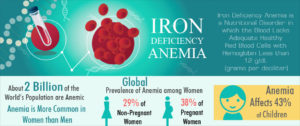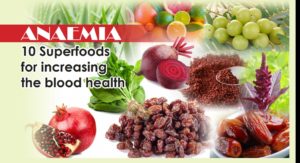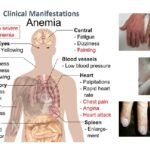

In the super epic Mahabharat, King Pandu, also famously known as the father of the pancha pandavas has a story for his Pandutwa (paleness). He is the son of Ambalika and Vyasa. During conception, Ambalika was frightened with Vyasa’s scary appearance and had become pale hence, her son was born pale, and so he was named Pandu. Ayurveda emphasis on the disease Anaemia or ‘Pandu’ (emphasizing the cardinal symptom- pale skin) with complete description of the causes, signs and symptoms, complications and treatment modalities. In Pandu, there is prabha (lustre) and kanti (charm) depletion which is due to rakta (Blood tissue) and ojakshaya (Ojas is the subtle essence of the physical body. It is that bright zeal that gives an extra health boost).
Anaemia is a blood disorder characterized by reduced levels of haemoglobin and its oxygen carrying capacity. Patients suffering from Pandu are usually unaware of the fact that, this disease can lead to some very serious complications in them. Anaemia is in fact a mark of a disease route rather than a disease itself. It is typically categorised as either chronic or acute. Chronic anaemia occurs over a long period of time. Acute anaemia occurs quickly. It is found that nutritional deficiency is the major etiological factor of the disease. Anaemia can occur due to production defects, maturation defects, and nutritional deficiencies, genetic factors, impaired metabolism of spleen, metabolic disorders etc.
The damage to standard colour of body or discolouration of skin is recognised as ‘Panduta’ (Pallor). When one is anaemic, the natural pink is lesser and much yellow or whitish tinge gets in. Along with this, we see symptoms like fatigue and loss of energy, rapid heart rate, shortness of breath and headache, difficulty to concentrate or loss of alertness, dizziness, leg cramps and insomnia, tinnitus, low digestive power, repugnance against food, body pains, fever, dyspnoea, heaviness, Swelling of the eyelids, weak hair follicles, irritable, drowsy, avoids speaking, sensitive to loud sounds and pain and weakness in the lumber region, thighs and feet. Most of these symptoms are seen in anaemic conditions.
Importance of Rakta (blood tissue):
Ayurveda explains seven dhatus (tissues) which are the main supporting pillars for a healthy body. They are 

10 Superfoods for increasing the blood health:
1. Raisins: A fistful raisins, especially in pregnancy is a magic for low hb as well as constipation. One-half cup of raisins contains 1.3 milligrams of iron.
2. Dates: Eat 2 dates a day to keep anaemia at bay, as it is loaded with nutrition and sweet by taste.

3. Pomegranate: They are rich in fibre, vitamins and minerals so it helps to reduce blood pressure.
4. Palak/Spinach: Regular consumption of spinach can prevent anaemia as it is an excellent source of iron. This mineral is particularly important for menstruating women and growing children and adolescents. It is also beneficial in lowering hypertension as some of its constituents help to reduce stress and anxiety.
5. Beetroot: It increases iron content and also the oxygen requirement. Beetroot helps in repairing and reactivating the red blood cells in the body, which further increases the supply of oxygen to all parts of the body.
6. Ragi: The staple food of South India and great for the bones, for maintaining sugar levels and keeping one pink with health. Ragi is an excellent source of natural iron and the sprouted ones are high in Vitamin C making absorption of iron easy in the body.
7. Citrus fruits: Which is very much required for absorption of iron. This enhances the metabolism, reducing the other symptoms of anaemia.
8. Amaranth: drinking its juice during the entire period of pregnancy helps the normal growth of the baby and prevents the extra use of calcium and iron from the body reserves. It relaxes the uterine ligaments, and eases child birth.
9. Amla: Gooseberries are loaded with nutrition and are used with iron preparations in Ayurvedic medicines. It is to be remembered that gooseberries are excellent rasayanas (rejuvenators)
10. Aloe Vera: An excellent liver cleanser and a detoxifier. But use under the prescription of a vaidya.
What’s not wholesome for anaemic individuals?
Foods which are heavy for digestion and which easily deplete the body’s energy levels are not wholesome. Excessive intake of sour tasting substances, salty pungent, astringent diet, foods that are hot and sharp in nature, foods that dry up the body tissues, foods that are not of compatible nature – either unwholesome or toxic after digestion. For example: urad dal, mustard, pastries, alcohol consumption, day sleep, eating spicy sharp tangy foods, consuming too much of water, heavy tissue depleting foods, smoking, sexual indulgence, anxiety, depression or excessive mood upsets, irritability, controlling natural urges, and heavy exercises.
What is wholesome?
Old rice, wheat, barley, jowar, green gram, bottle gourd, chow chow, spinach, bitter gourd, ridge gourd, palak, shepu, turmeric, amla, grapes, anjeer, chikoo, banana, mango, dates, pomegranate, papaya, garlic, ginger, Cow milk, ghee, butter, buttermilk, Cow’s urine, parched rice gruel, decoctions of vata pacifying herbs and light exercise is wholesome.
Anemic conditions can be as a result of different pathologies. Recognizing accordingly and administering the right combination of iron preparations serves the health requirements. Iron preparations strengthen the blood tissue. The muscle tissues, the wind bioenergy, ligaments, tendons, brain and other organs don’t function properly in anemic conditions and hence aphrodisiacs and rejuvenators called as Rasayanas are administered with iron preparations.


Dr. Sanmathi P Rao
Sriranga Ayurveda
10/2, Bugle rock road, Basavanagudi
Bangalore-560004
Ph.: 080-26627717
Mob: 7829488352











